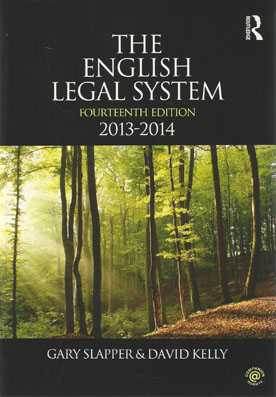Book review: Slapper and Kelly, The English Legal system
The English Legal system, 14th ed (2013-2014), by Gary Slapper and David Kelly (Routledge, £32.99). As the authors point out in their introduction, the English legal system has evolved over a period of more than a thousand years, and continues to evolve daily. It needs a textbook of sufficient heft and vigour to keep up
The English Legal system, 14th ed (2013-2014), by Gary Slapper and David Kelly (Routledge, £32.99).
 As the authors point out in their introduction, the English legal system has evolved over a period of more than a thousand years, and continues to evolve daily. It needs a textbook of sufficient heft and vigour to keep up with it, and this they certainly provide.
As the authors point out in their introduction, the English legal system has evolved over a period of more than a thousand years, and continues to evolve daily. It needs a textbook of sufficient heft and vigour to keep up with it, and this they certainly provide.
To take just one example, in 2013, the year of publication, the Legal Aid, Sentencing and Punishment of Offenders Act 2012 (LASPO) came into force – on, of all days, 1st April (April Fools Day). This implemented sweeping changes to the provision of civil legal aid, largely by rendering it unavailable for a range of previously covered types of claim. The authors point out that in 1950, 85% of the English population was covered by the legal aid system, whereas by 2012, when LASPO was passed, the proportion of people covered had fallen to 25%.
The consequence has been a pronounced rise in the number of self-represented “litigants in person” (LIPs). This in turn conjures up the prospect of a legal system in which, at least in terms of civil litigation, many of those taking part are non-lawyers and will probably never have studied law or read a book like this one. (If that seems acceptable, consider a health system in which the same proportion of people were forced to do the job themselves, and had not read Gray’s Anatomy. )
For anyone studying law, The English Legal System provides a comprehensive survey of the types and sources of law, including domestic and European legislation, case law, commentary and custom. Again, the way things have changed is remarkable. “In its early stages of development, the legal system had no organised law reporting … whereas today we have libraries full of voluminous law reports and all major decisions published in full online.” One might go further: nearly all decisions of the senior courts (the High Court and above) are also published online, regardless of importance.
Although only one of the sources of law, the system of precedent and stare decisis (“let the decision stand”) which characterises the Common Law is a unique development of the English legal system, though it has been exported to other English-speaking jurisdictions, and now adapted to some extent in pan-European jurisdictions such as that of the Court of Justice of the European Union and the European Court of Human Rights. Given the importance of binding precedent to the English legal system, we are gratified to note that, in their brief history of law reporting, the authors pay proper attention to the formation, in 1865, of what became the Incorporated Council of Law Reporting for England and Wales (ICLR), “under the auspices of the Inns of Court and the Law Society with the aim of producing quicker, cheaper and more accurate reports than had been available previously”.
The other major source of law is legislation. The authors describe how Bills are introduced into one or other House of Parliament, discussed and amended by both houses, and eventually passed into law. But that is not the end of the story. Acts of Parliament need to be enforced, and that almost inevitably gives rise to disputes over their interpretation. How are these resolved? By the courts, thus giving rise to yet more law, in the form of judicial decisions explaining the meaning and effect of legislative provisions. If Parliament thinks the courts have misinterpreted the legislation, it can pass another statute, amending the earlier one, and so in turn give rise to more disputes over interpretation and fresh case law. And so the evolution continues.
In discussing the nature of law in chapter 1, the authors comment on the ongoing debate about the relationship between law and morality. “Should all laws accord with a moral code, and, if so, which one? Can laws be detached from moral arguments?” In chapter 2 they go on to discuss the related issues of the rule of law and human rights. The fluidity of these concepts makes any idea of studying law purely from the point of view of a “black letter” legal perspective impossible. Moreover, this is yet another area in which views have changed over time.
A book like this, compendious as it is, cannot hope to cover everything in 800-odd pages. Any student of law will need to branch out into more detailed avenues of study for particular subjects, such as crime and criminal procedure, contract, tort, land law and so forth. What this book provides is a sort of home base from which to make sorties into different subject matter areas. It deals in legal concepts, abstractions, theory, method, practice, and context – in particular the historical context. For in everything they write, the authors remind the reader that whatever is currently in place has arrived or replaced something else at a certain point in the English legal system’s thousand-year history. There is no room in their book for a creationist approach to the legal system. (And that, incidentally, is why we don’t have now, and probably never will have, a fully comprehensive written constitution, or even a criminal code.)